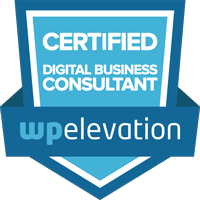A Best-Fitting Tech Solution: Build Your Website Like an App
As more small businesses and startups consider how to best shift to an online platform, it’s important to first consider which solution best fits your budget and consumer needs. Many startups first consider building a native app, ahead of considering other possible avenues that may be less cost and labor intensive.
A website app, or web app, is a possibility that might best meet your near and mid-term business goals.
At Tiny Blue Sky, we believe that deriving a web solution is not one-size-fits-all; there are pros and cons to building either a native app, a website, or a web app. Not all considerations are technical ahead of your build, and there are experts that can help guide you through the process. We have clients turn to us as creative technical partners as they make the decisions that work best for them.
One of our clients, Ends + Stems, turned to us for support in building a web app in 2018. Founder and Chef Alison Mountford sought an interactive experience, and believes that the web app designed by Tiny Blue Sky helps her achieve a customized approach for her clients that best meets their ever-changing lifestyle, all while reducing household food waste. Says Chef Alison, “Starting with a web app and working with TBS to figure out which parts to build first has allowed me to work on a reasonable budget and not over build/over spend, which is very common with mobile apps. One of the biggest benefits for a web app turns out being that you can use emails and social media to drive people directly to your site. This is one of the best and most affordable ways to do marketing and with a mobile app you don’t get that.”
If you think that a web app is the solution for you, here are some considerations to keep in mind:
Set Your Budget and Stick to It
A native app can be anywhere from $10K-100K to build from the start, whereas a web app can cost just a few thousand dollars to start. It all depends on the goals of the product itself. Web developers help determine the MVP, or minimum viable product, when beginning the design and layout of a web solution. Your MVP is the least technically intricate option that is deployed to help get your product online. It helps you assess your consumer needs and informs how to scale up your build. It can even help test the viability and need for launching a native app in the future.
Launching an app will come with additional costs post launch. This includes ensuring that it works across iOS and Android operating platforms. Each time these systems make adjustments and updates, the app itself will need to be updated as well. With a web app, you will not have to update by operating system, as a web app solution stores browser data and some data is accessible offline.
Attracting Clients and Standing Out Against the Competition
You want to attract clients and support their needs rather than encourage them to shop elsewhere. There are several ways to maintain a competitive advantage in the app world, each of which includes research.
Your consumer needs should drive your technical solution investment.
There is already so much competition in the app world. Major ones such as Google and Facebook are leaders and achieve thousands of downloads and hours of use daily. Even those on a smaller scale compete to achieve reach and are constantly trying to attract new customers to download their solutions. It costs to keep up and stay on top. In order for an app to support the sustainability of business, people will have to continuously demand your services, which means downloading your app. If the demand doesn’t exist, then the sustainability of your app is diminished.
A Case Study: Ends + Stems
Chef Alison strongly considered both a mobile responsive site and an iOS app at the very beginning of her technical journey, thinking these options were the best ways to convey information to her client-base and react to consumer insights. The concept of a web app was new to Alison, and it incorporated the best of both a mobile responsive site and an app in one product. “With a web app you can use email marketing to drive customers to your site and you can make updates anytime without requiring users to download a new version- you can’t do either of those very important things with an iOS app,” says Alison. “A mobile responsive site wouldn’t have given me quite enough interaction and customization of the user experience; I would have had to shelve more of my goals for the site had we gone in that direction.”
Equipped with her product outline and a set product launch budget, she found the process of designing and launching her company’s web app, based on a WordPress CMS, to be seamless. Knowing her budget at the start was key in making that happen. “Having [a] set price allowed me to feel confident in the launch budget and not have any unwanted surprises during building and up through launch.” Ends + Stems is now a year-old business that started gaining traction from a strong social media presence, and the web app only enhances her client engagement and makes doing business easier. Says Alison, “Design wise, people comment all the time that they can’t believe my business is only 1-year old and run by a full time team of one because the site looks so gorgeous and professional. The integrations with Stripe, PayPal and how that all seamlessly interacts with my MailChimp account has been the most beneficial because it allows me to automate new customers, payments, and communication so I can focus on other things.”
If you don’t view yourself as tech-savvy, you shouldn’t feel less confident about pursuing a technical solution to help drive your business forward. Chef Alison believes strongly that “we might not know how to code but we are technology users, so we do know what to expect from an app or website. We’ve seen it done by other companies that we use and hire so I think most business owners can imagine what they want technology to do for them.”
Taking your business idea online can be a reality, with a right-sized vision, the right budget, and a strong creative technology partner that is up for the challenge. Ultimately, only you can decide what solution will work best for your business. At Tiny Blue Sky, we are here to support your business growth as your creative technical partner. Reach out to us today to get started and to learn more.



